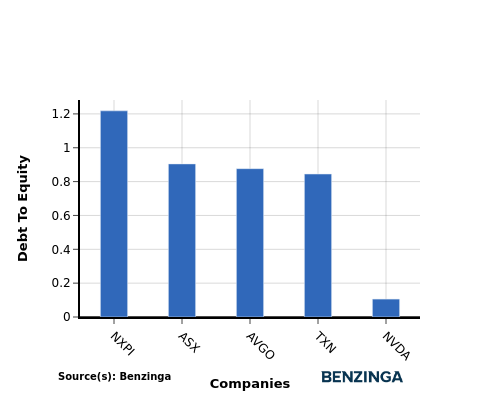Analyzing NVIDIA In Comparison To Competitors In Semiconductors & Semiconductor Equipment Industry
In the ever-evolving and intensely competitive business landscape, conducting a thorough company analysis is of utmost importance for investors and industry followers. In this article, we will carry out an in-depth industry comparison, assessing NVIDIA (NASDAQ:NVDA) alongside its primary competitors in the Semiconductors & Semiconductor Equipment industry. By meticulously examining key financial metrics, market positioning, and growth prospects, we aim to offer valuable insights to investors and shed light on company's performance within the industry.
NVIDIA Background
Nvidia is a leading developer of graphics processing units. Traditionally, GPUs were used to enhance the experience on computing platforms, most notably in gaming applications on PCs. GPU use cases have since emerged as important semiconductors used in artificial intelligence to run large language models. Nvidia not only offers AI GPUs, but also a software platform, Cuda, used for AI model development and training. Nvidia is also expanding its data center networking solutions, helping to tie GPUs together to handle complex workloads.
| Company | P/E | P/B | P/S | ROE | EBITDA (in billions) | Gross Profit (in billions) | Revenue Growth |
|---|---|---|---|---|---|---|---|
| NVIDIA Corp | 57.69 | 49.24 | 30.22 | 28.72% | $31.94 | $33.85 | 55.6% |
| Broadcom Inc | 94.78 | 23.82 | 29.84 | 5.8% | $8.29 | $10.7 | 22.03% |
| Advanced Micro Devices Inc | 153.37 | 6.97 | 14.12 | 1.48% | $0.72 | $3.06 | 31.71% |
| Micron Technology Inc | 29.48 | 4.64 | 6.74 | 6.1% | $5.9 | $5.05 | 46.0% |
| Qualcomm Inc | 17.46 | 7.17 | 4.67 | 9.71% | $3.52 | $5.76 | 10.35% |
| Intel Corp | 1333 | 1.79 | 3.29 | 3.98% | $0.47 | $3.54 | 6.17% |
| ARM Holdings PLC | 257.30 | 25.67 | 43.86 | 1.88% | $0.17 | $1.02 | 12.14% |
| Texas Instruments Inc | 29.41 | 8.82 | 8.56 | 8.21% | $2.24 | $2.72 | 14.24% |
| Analog Devices Inc | 59.58 | 3.38 | 11.23 | 1.5% | $1.33 | $1.79 | 24.57% |
| NXP Semiconductors NV | 25.85 | 5.24 | 4.42 | 6.43% | $1.11 | $1.79 | -2.37% |
| ASE Technology Holding Co Ltd | 31.71 | 3.38 | 1.72 | 3.56% | $32.4 | $28.88 | 5.29% |
| Credo Technology Group Holding Ltd | 260.58 | 41.54 | 58.15 | 8.67% | $0.07 | $0.15 | 273.57% |
| First Solar Inc | 20.49 | 3.18 | 5.68 | 5.19% | $0.61 | $0.61 | 79.67% |
| STMicroelectronics NV | 42.19 | 1.22 | 1.93 | 1.33% | $0.64 | $1.06 | -1.97% |
| ON Semiconductor Corp | 47.70 | 2.58 | 3.32 | 2.13% | $0.38 | $0.55 | -15.36% |
| United Microelectronics Corp | 14 | 1.65 | 2.48 | 4.29% | $30.07 | $17.62 | -2.25% |
| Skyworks Solutions Inc | 30.96 | 2.04 | 3.06 | 1.81% | $0.23 | $0.4 | 6.57% |
| Rambus Inc | 48.95 | 8.59 | 16.48 | 3.84% | $0.08 | $0.14 | 22.68% |
| Average | 146.87 | 8.92 | 12.91 | 4.47% | $5.19 | $4.99 | 31.36% |
Through a meticulous analysis of NVIDIA, we can observe the following trends:
The stock's Price to Earnings ratio of 57.69 is lower than the industry average by 0.39x, suggesting potential value in the eyes of market participants.
It could be trading at a premium in relation to its book value, as indicated by its Price to Book ratio of 49.24 which exceeds the industry average by 5.52x.
With a relatively high Price to Sales ratio of 30.22, which is 2.34x the industry average, the stock might be considered overvalued based on sales performance.
The company has a higher Return on Equity (ROE) of 28.72%, which is 24.25% above the industry average. This suggests efficient use of equity to generate profits and demonstrates profitability and growth potential.
The company exhibits higher Earnings Before Interest, Taxes, Depreciation, and Amortization (EBITDA) of $31.94 Billion, which is 6.15x above the industry average, implying stronger profitability and robust cash flow generation.
The gross profit of $33.85 Billion is 6.78x above that of its industry, highlighting stronger profitability and higher earnings from its core operations.
The company is experiencing remarkable revenue growth, with a rate of 55.6%, outperforming the industry average of 31.36%.
Debt To Equity Ratio

The debt-to-equity (D/E) ratio assesses the extent to which a company relies on borrowed funds compared to its equity.
Considering the debt-to-equity ratio in industry comparisons allows for a concise evaluation of a company's financial health and risk profile, aiding in informed decision-making.
When evaluating NVIDIA alongside its top 4 peers in terms of the Debt-to-Equity ratio, the following insights arise:
NVIDIA has a stronger financial position compared to its top 4 peers, as evidenced by its lower debt-to-equity ratio of 0.11.
This suggests that the company has a more favorable balance between debt and equity, which can be perceived as a positive indicator by investors.
Key Takeaways
For NVIDIA, the PE ratio is low compared to peers, indicating potential undervaluation. The high PB and PS ratios suggest strong market sentiment and revenue multiples. In terms of ROE, EBITDA, gross profit, and revenue growth, NVIDIA outperforms its industry peers, reflecting strong financial performance and growth prospects.
This article was generated by Benzinga's automated content engine and reviewed by an editor.
 Nasdaq
Nasdaq Wall Street Journal
Wall Street Journal